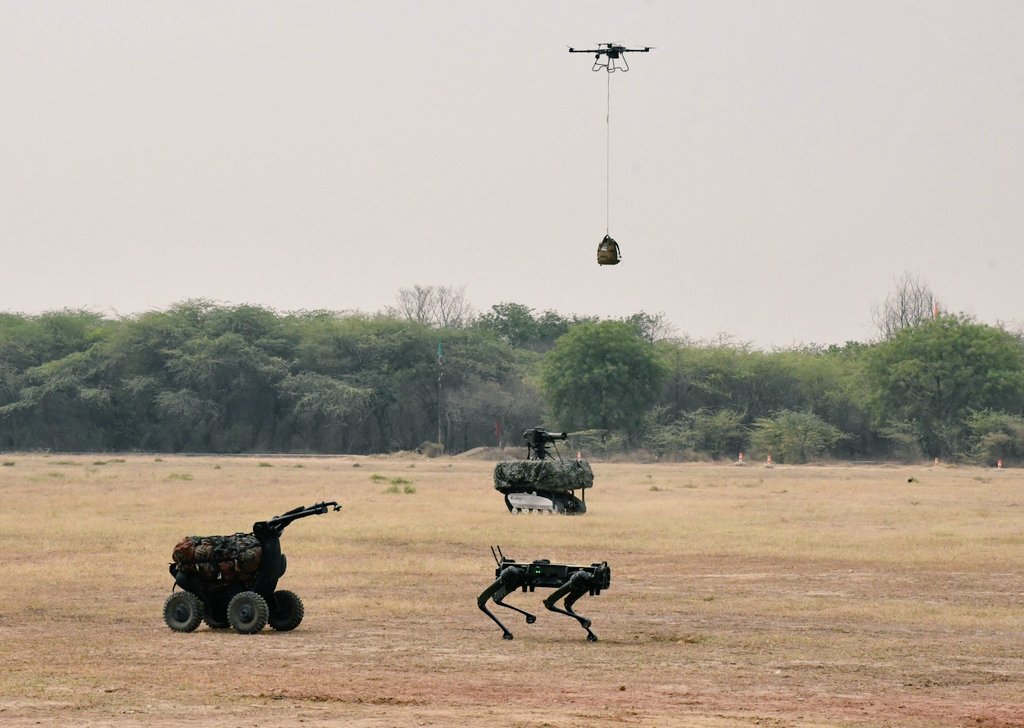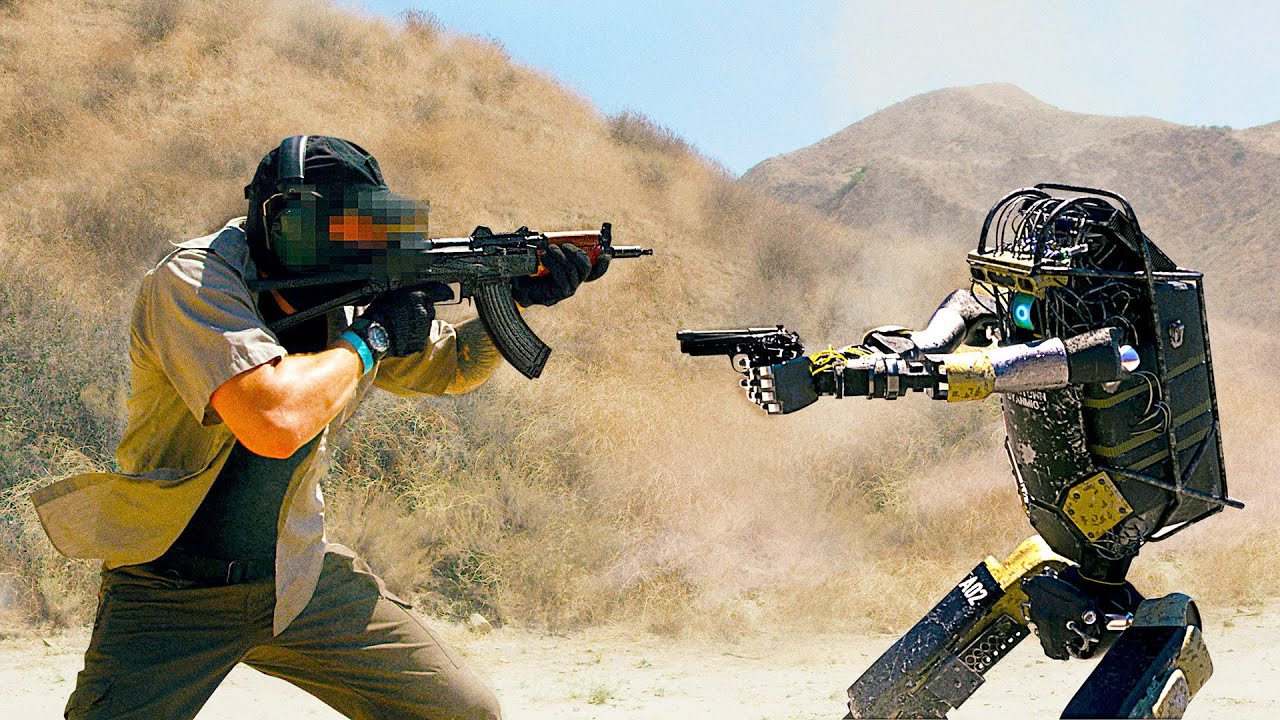Beijing is using the ongoing China-Cambodia wargames to showcase its latest weapon platforms, like the machine-gun-toting “robodog.” amid tensions with India over the disputed Himalayan border. Interestingly, the Indian Army announced the deployment of its high-altitude logistics drone, “Airawat” (Elephant), along the China border.
The spiraling relationship between the two Asian giants and the Ukraine-Russia war has fueled the development of drones in the region. Both internal and international wargames are a way of validating these technologies.
The largest military drill between China and Cambodia saw around 2,000 troops. The exercise, called “Golden Dragon,” included 14 warships, helicopters, and almost seventy armored vehicles and tanks. The 15-day exercise included live fire exercises, anti-terrorism training, and humanitarian and rescue drills. However, the Robodogs were the stars of the show.
The armed “robodogs” came equipped with remote-controlled drone soldiers with back-mounted machine guns. There have been no reports of live-fire demonstrations by these robodogs, but the top Cambodian brass did get a taste of its mobility.
The exercise comes as China’s only overseas military base besides Djibouti is up and running. The EurAsian Times earlier reported that satellite imagery indicates that two Chinese navy ships have been docked at Cambodia’s Ream Naval Base for over four months, despite repeated concerns expressed by the United States.
The facilities will help deploy warships and coastguard vessels around the region at short notice, increasing China’s footprint in the region. They will also give China access to Southeast Asian Sea lanes like the vital Straits of Malacca, which would enhance logistics and intelligence monitoring.
The aircraft carrier-size pier at Ream base and dry dock facilities will provide the PLA-N with an extended presence in the Bay of Bengal and affect the balance of power in the region.
India Bets Big On Drones
The Indian Army’s Airawat has sophisticated navigation systems and a robust payload capacity. It can navigate the treacherous Himalayan terrain.
During its trials, the drone reached a height of 5,000 meters near the Indo-China border, showcasing its superior capability in extreme weather. Airawat can conduct autonomous flights, with a 10 km round trip and remaining airborne for up to 40 minutes at high altitudes.

The Indian Army also has its robot dogs, the Multi-Utility Legged Equipment (MULE). The four-legged droid has a sleek design and carries thermal cameras and radars. Recently, the Indian Army’s Central Command showcased a robotic mule, logistic drone, unmanned ground vehicle, and a tactical load hauler at Agra Military station.
#IndianArmy#SuryaCommand
Lt Gen NS Raja Subramani, GOC- in C, #SuryaCommand visited #ShatrujeetBrigade & #Agra Military Station. Army Commander reviewed the operational preparedness of the Brigade and witnessed the latest technology like Robotic Mules and Logistic Drones. He… pic.twitter.com/zIqrvYxfFe— SuryaCommand_IA (@suryacommand) May 12, 2024
Lt Gen NS Raja Subramani, General Office in Commanding of the Central Command, appraised the integration of the latest technology, such as Robotic Mules and Logistic Drones, into the force.
Apart from cameras and sensors, the Robodog can be mounted with small arms to fire at enemy positions while keeping soldiers away from harm. It can traverse all terrains, including snowy and rough. The robot can even climb mountains, with climb steps as high as 18 centimeters.
War Of Drones In The Himalayas
In the past decade, there have been several confrontations between Indian and Chinese troops. In 2020, as the troops from the two countries clashed in the Galwan Valley, a DJI Mavic Pro 2 UAV was used to unfurl the Chinese flag in front of the PLA troops.
The act aimed at furthering the troops’ nationalistic fervor is also a glimpse of the use of UAVs at the frozen heights.
UAVs are becoming an important weapon in China’s arsenal. In 2021, a Chinese legislator—a former commander of a border regiment on the plateau—called for the increased and enhanced use of UAVs. He called them essential to the operations of the Chinese military as they can “see what troops can’t see, hear what troops can’t hear, and go where troops can’t go.” China has the greatest number of UAV development programs.
In a July 2023 paper for the Foundation for Strategic Research, Antoine Bondaz and Simon Berthault note that UAVs have become an indispensable force for China in the Himalayan environment, enabling the autonomy of support systems, intelligent command, search and rescue, and swarming attacks.
China has deployed increasing numbers of UAVs along its border with India. These UAVs enable the PLA’s Tibet Military Command to facilitate “equipment supplies, defense and management of the border, and armed surveillance and reconnaissance.”
The UAV operation suits the Himalayan topography. They can take off in less space, especially VTOL quadrotors or UAVs catapult-launched from a truck. Also, their ability to fly closer to the ground makes them stealthy and increases their chances of penetrating the enemy lines.
According to Chinese publications, UAVs deployed on the border with India perform a variety of missions, such as support for logistical transport, border surveillance, combat damage assessment, artillery observation, sniper support, mine clearance, search and rescue, and communication support.
China is using drones for “last mile” connectivity. Their border outposts are located three to 14 days’ walk from the maintenance and supply distribution center, making supply lines vulnerable to disruption by landslides and snowfalls. China is working towards a “road transport + UAV logistics distribution” model.

Most of the UAVs deployed on the Tibetan plateau have a payload capacity of a few tens of kg, but it can go up to two tons for certain heavy UAVs. The AT-200 unmanned utility aircraft, inspired by New Zealand’s PAC 750, has a payload capacity of 1.5 tons.
This civilian utility UAV can be used for military transport. At the 2018 Singapore Airshow, the UAV was shown as potentially linking Chengdu to Ngawa County on the Tibetan plateau at the Sino-Indian border.
India has also accelerated its drone acquisition and development programs. It has used MQ-9B drones taken on lease from the US to do reconnaissance along the Indo-China border and is now importing 31 of these to boost its drone power. India will also operate the Israeli Hermes 900 UAVs, aka Drishti 10 Starliner.
In December 2017, an Israeli-made Heron in the Indian Army crashed on the Chinese side of the border near the Doklam Plateau, where India and China have been engaged in a standoff.
China protested this ‘air intrusion’ after the incident, whereas India alerted its Chinese counterparts of the crash, saying it was on a regular training mission.
The Indian Herons have been deployed to at least four bases in North East India—Tezpur Air Force Station in 2015, Bagdogra Air Force Station in 2017, Chabua Air Force Station in 2018, and Kumbhirgram Air Force Station in 2019.
The confrontation with China has fuelled India’s quest for drones, and there will be huge developments in the field in the coming days.
- Ritu Sharma has been a journalist for over a decade, writing on defense, foreign affairs, and nuclear technology.
- The author can be reached at ritu.sharma (at) mail.com
- Follow EurAsian Times on Google News




